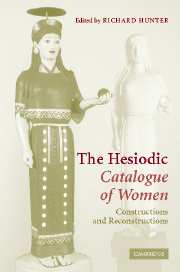Book contents
- Frontmatter
- Contents
- Notes on contributors
- Acknowledgements
- List of abbreviations
- Introduction
- 1 Ordering women in Hesiod's Catalogue
- 2 The beginning and end of the Catalogue of Women and its relation to Hesiod
- 3 Gods among men? The social and political dynamics of the Hesiodic Catalogue of Women
- 4 Heracles in the Hesiodic Catalogue of Women
- 5 Mestra at Athens: Hesiod fr. 43 and the poetics of panhellenism
- 6 A catalogue within a catalogue: Helen's suitors in the Hesiodic Catalogue of Women (frr. 196–204)
- 7 Pulp epic: the Catalogue and the Shield
- 8 The Megalai Ehoiai: a survey of the fragments
- 9 Ordered from the Catalogue: Pindar, Bacchylides, and Hesiodic genealogical poetry
- 10 The Hesiodic Catalogue and Hellenistic poetry
- 11 From genealogy to Catalogue: the Hellenistic adaptation of the Hesiodic catalogue form
- 12 The Hesiodic Catalogue of Women and Latin poetry
- 13 Or such as Ovid's Metamorphoses …
- Bibliography
- Index of passages discussed
- General index
7 - Pulp epic: the Catalogue and the Shield
Published online by Cambridge University Press: 22 September 2009
- Frontmatter
- Contents
- Notes on contributors
- Acknowledgements
- List of abbreviations
- Introduction
- 1 Ordering women in Hesiod's Catalogue
- 2 The beginning and end of the Catalogue of Women and its relation to Hesiod
- 3 Gods among men? The social and political dynamics of the Hesiodic Catalogue of Women
- 4 Heracles in the Hesiodic Catalogue of Women
- 5 Mestra at Athens: Hesiod fr. 43 and the poetics of panhellenism
- 6 A catalogue within a catalogue: Helen's suitors in the Hesiodic Catalogue of Women (frr. 196–204)
- 7 Pulp epic: the Catalogue and the Shield
- 8 The Megalai Ehoiai: a survey of the fragments
- 9 Ordered from the Catalogue: Pindar, Bacchylides, and Hesiodic genealogical poetry
- 10 The Hesiodic Catalogue and Hellenistic poetry
- 11 From genealogy to Catalogue: the Hellenistic adaptation of the Hesiodic catalogue form
- 12 The Hesiodic Catalogue of Women and Latin poetry
- 13 Or such as Ovid's Metamorphoses …
- Bibliography
- Index of passages discussed
- General index
Summary
‘All normal people need both classics and trash.’ George Bernard Shaw's adage, comforting to those whose personal preferences lean towards rap music rather than Rigoletto, can also apply to the professional realm. Trash and classics go hand in hand. Mutually self-defining as these are, however, one rarely finds them brought together in the same critical discourse, any more than one finds them embodied in a single writer (apart from rarities like the noir novelist Raymond Chandler, who took top marks in the Civil Service classics exam of 1907).
In this paper, I propose to reread a problematic classical (if not classic) text, the Shield of Heracles attributed to Hesiod, by using a ‘trash aesthetic’. Explicit reference to this aesthetic has increasingly played a role in the analysis of a wide range of artistic productions and cultural forms, from trailer parks to New Jersey hairstyles to Bill Clinton's girlfriends. Film bulks largest in the aesthetic consideration of trash, and vocabulary and examples from movies will be useful in this analysis. The subcategory of trash analysis centring on verbal narrative (called ‘pulp theory’ after the novels – like Chandler's – once thought to be worth less than the cheap paper they were printed on) will also prove helpful.
The discovery of a likeness between pulp film and written narrative is of course nothing new, as the media have always been symbiotic in production as in reception.
- Type
- Chapter
- Information
- The Hesiodic Catalogue of WomenConstructions and Reconstructions, pp. 153 - 175Publisher: Cambridge University PressPrint publication year: 2005
- 41
- Cited by



